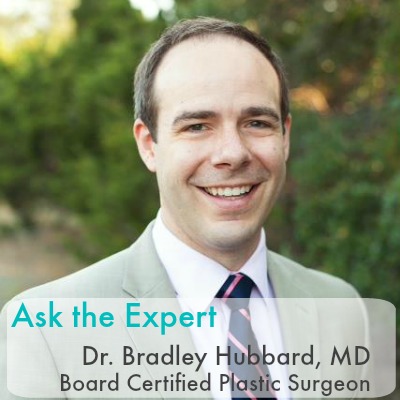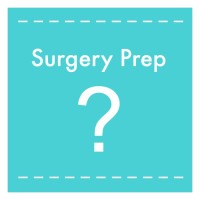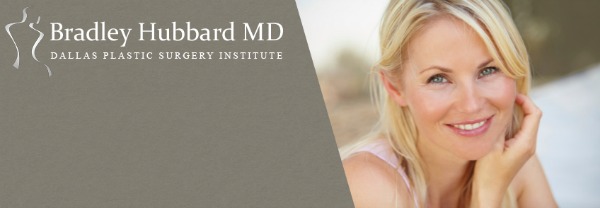This post has been sponsored by Dr. Bradley Hubbard, M.D.
As moms, we all know our bodies can go through some pretty major changes from pregnancy, nursing and beyond. Once you’ve come out of the fog of the newborn stage, a lot of moms start trying to get back to their pre-pregnancy shape. Even if all the ‘baby weight’ has been lost, the body just doesn’t look the same. Have you ever considered a surgical procedure? I’d be lying if I said the thought hadn’t crossed my mind. That’s where our expert today comes in.
Our guests who attended the DFW Moms Night Out had the chance to mingle with Dr. Bradley Hubbard, MD. He’s a Board Certified Plastic Surgeon and a member of the renowned Dallas Plastic Surgery Institute. We sat down with Dr. Hubbard to answer some of the most common questions about plastic surgery, specifically procedures that might interest moms. We conducted an informal poll among some of our readers, and not surprising, their most asked plastic surgery questions had to do with their post-baby bodies.
had the chance to mingle with Dr. Bradley Hubbard, MD. He’s a Board Certified Plastic Surgeon and a member of the renowned Dallas Plastic Surgery Institute. We sat down with Dr. Hubbard to answer some of the most common questions about plastic surgery, specifically procedures that might interest moms. We conducted an informal poll among some of our readers, and not surprising, their most asked plastic surgery questions had to do with their post-baby bodies.
 Pregnancy and breastfeeding have completely changed my breasts, what can I do to get them looking like they did pre-baby?
Pregnancy and breastfeeding have completely changed my breasts, what can I do to get them looking like they did pre-baby?
During pregnancy and breast feeding the breasts can enlarge a great deal. After the engorgement subsides, the elastic tissue in the skin has to retract to maintain your pre-baby shape. This doesn’t happen for everyone, especially after baby 2 or 3. The other change with pregnancy is deflation. Most women notice that their breasts look deflated in volume especially in the upper portion of the chest compared to pre-baby. Of course this can be restored or possibly improved from your pre-baby shape/size. I think there are three types of mom’s, each with different surgical needs:
- Happy with volume, not happy with shape/droop/nipple position: breast lift alone
- Happy with shape and nipple position, but the breast looks deflated: breast implant alone
- Unhappy with shape and size: implant and lift
What is the difference between a breast enhancement and a breast lift?
Breast enhancement could mean a lot of things, I try to stay away from that term. I usually use the terms breast lift and breast augmentation. Breast augmentation simply means making the breasts you have larger. Breast lift means tightening the skin of your breast (make the shape more perky/less droop) and placing the nipple in the right position (on the front and center of the breast pointing straight forward).
What kind of recovery can I expect from breast surgery? When can I pick up my kids again, when can I drive, etc?
Different people have different pain tolerances. On average, breast lift and breast reduction have 2-3 days of pain requiring narcotic pain medications. The majority of people are back to work after 1 week. Any breast procedure with an implant will add 1-2 days to the recovery. A word of caution to Moms, do not choose your plastic surgeon based on promises of a fast recovery. Promises of fast recovery are usually a marketing technique and nothing more.
After breast surgery, most doctors will require their patients to wear a supportive bra 24/7 for 4-6 weeks. exercise and heavy lifting should be avoided for 7-10 days after reduction or lift, 4-6 weeks after breast implants. Driving can be resumed if you are not taking narcotic pain medications.
 I have this lingering “baby bump” on my tummy, what do you suggest to get rid of it?
I have this lingering “baby bump” on my tummy, what do you suggest to get rid of it?
There are three causes of a persistent “baby bump”: over-stretched muscles of the abdominal wall, abnormal deposition of fat, and/or excess skin of the abdomen.
If the problem is the muscles of the abdominal wall, strengthening those muscles with countless sit-ups and core-exercises can help to some degree. However, if when doing a sit-up you see a vertical ridge or bulge up the middle of your abdomen only surgery can help. This is a condition known as rectus diastasis, or a separation of your rectus (six-pack) muscles. If the connective tissue between these muscles is stretched, sit-ups will NOT help. Surgery is required to place the muscles back to their original position.
If the problem is a collection of fat, losing weight can certainly help. As many moms know, their body will preferentially store fat in certain areas. Almost every person is different. Some store fat in their hips, legs and buttocks (pear shape) where as some store it more evenly (apple shape). Regardless of shape, losing weight will always shrink these areas. For this reason, I want my patients to be at their “goal” or “normal for them” weight prior to any body contouring intervention.
Some women can be extremely skinny with one pesky area of fat deposition (e.g. lower abdomen or outside of the thigh). These are great candidates for liposuction or non-invasive fat removal like coolsculpting or liposonix. The key for anyone considering fat reduction procedures surgical or non-invasive is the quality of their skin in that area. If the skin elastic tissue is not adequate, removal of the underlying fat is going to make the skin more loose. In these situations, fat removal should not be performed unless simultaneous skin tightening is done.
If there is excess skin of the abdomen, tummy tuck is usually necessary. In a tummy tuck procedure, all of the above issues can be addressed. Excess fat is removed, muscle repair is performed and excess skin is removed. Usually all of the skin from the pubic hair to the belly button can be removed. Say goodbye to the skin with all the stretch marks!
Is there such a thing as a “mini tummy tuck”?
Beware of marketing scheme’s with terms like “mini-tummy tuck”. Most mom’s hear this term and think “mini scar”, but usually that is not what is being offered. However, there are many different styles of tummy tuck (aka abdominoplasty). I use 5 different styles depending on my patients needs. Liposuction can be added to any of these procedures if needed.
- Mini tummy tuck: Indications: excess skin ONLY below the belly button and a relatively tall patient >5’5”. The scar is slightly shorter, there is no scar around the belly-button, muscle repair can be done if needed.
- Traditional tummy tuck: Indications: excess skin above and below the belly button or all patients <5’5”. The scar is from hip bone to hip bone (kept below panty line), scar around belly button, and muscle repair if needed.
- Extended tummy tuck: Indications: patients who also have hip fullness and poor skin elasticity. Liposuction of their hips would likely cause skin excess in the hip/ lateral thigh. The scar is taken further around the patient to tighten the skin of the hips.
- Circumferential tummy tuck or lower body lift: Indications: patients that have lost ~100lbs or more. The scar wraps completely around the patient (again below panty line). The buttocks is lifted, the lateral thigh and hip are tightened and the abdominal skin is tightened. Muscle repair is usually necessary.
- Panniculectomy: This is a procedure covered by insurance. To qualify the skin of your abdomen must hang below your pubic bone.
 There are some areas on my body with extra fat, like love handles, inner and outer thighs, etc. Is liposuction the only option for slimming those areas?
There are some areas on my body with extra fat, like love handles, inner and outer thighs, etc. Is liposuction the only option for slimming those areas?
There are very effective non-invasive fat reduction procedures. The two most popular are coolsculpting and liposonix. These procedures are done in the office without general anesthesia. They are well tolerated and have little downtime. Most patients will go back to work immediately after treatment. Basically, the instruments deliver energy through the skin damaging only the fat cells. Over 2-3 months the body will remove these fat cells. Usually multiple treatments are needed to achieve your goal shape, therefore the cost of liposuction vs. non-invasive techniques is fairly similar. It is very rare to be satisfied by one treatment as opposed to liposuction where one treatment is always adequate.
 Should I lose all of the “baby weight” before having a surgical procedure?
Should I lose all of the “baby weight” before having a surgical procedure?
I would advise anyone to be as close as possible to a weight that is normal for them. To put a number to it, if you are within 10% of that goal weight I think surgery would be safe. The idea is to make the shape, contour and skin tightness perfect for the long term. If you were to lose more weight post surgery, excess skin and droop could recur. Nobody wants to do these surgeries twice!
 What do I look for in a surgeon? How do I know a “good” surgeon when I see one?
What do I look for in a surgeon? How do I know a “good” surgeon when I see one?
This is a very difficult problem facing patients, especially in DFW where there are over 100 plastic surgeons to choose from. Moms should be comforted that many of my colleagues are awesome people and awesome surgeons. As a rule, I think you should see more than one doctor before going forward with surgery. It is important to have a comparison: are the recommended surgeries the same, who has better bedside manner, who has a more attentive staff? If there are any red-flags while they are “selling” you the surgery, I can guarantee many more problems after they have your money.
The next part is very important, but can be confusing. I personally think the most important qualification is being “Plastic Surgery” trained and “Board Certified” by the American Board of Plastic Surgery. There are some “Facial Plastic Surgeons” (ENT doctors) or “Oculoplastic Surgeons” (Ophthalmologists) who are very well qualified to take care of cosmetic surgery above the collarbones, but I can’t speak to the reliability of those titles. Be very, very cautious of terms like “Cosmetic Plastic Surgeon” or “Aesthetic Surgeon” (General Surgeons, OB/GYN, Medicine Doctors). These doctors may have some good results and may have experience, but they have not had the appropriate training to do these surgeries.
Here are five quick questions:
- Are you board certified and by what board?
- How many years of cosmetic surgery training did that take? (Plastic Surgery 5-7yrs, Facial Plastic 1-2yr, Oculoplastic 1yr, Cosmetic or Aesthetic Surgeon 0-1yr)
- How many years have you been operating?
- Can I look at your before and after pictures? (beware of patient’s with no scars or scars that are covered up)
- If there is a complication, who covers the cost of the revision?
——————
If you have lingering questions or are curious about any of the above surgical procedures, be sure to visit Dr. Hubbard’s website and blog. You can even schedule a complimentary consultation with Dr. Hubbard directly from his website. Dr. Hubbard can also be found on Facebook and on Instagram @bradleyhubbardmd.














